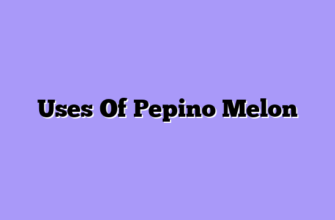Well, hello there, fruit lovers! It’s Ann here, your friendly neighborhood exotic fruit farmer. Today, I’m going to let you in on a little secret – how to tell when a pepino melon is ripe and ready for that first delicious bite. Now, you might know this quirky little fruit by other names like melon pear, tree melon, or even sweet cucumber. Heck, some folks even call it the “virgin fruit” (don’t ask me why – maybe because it’s so pure and sweet?). But no matter what you call it, knowing when it’s ripe is key to enjoying this Solanum muricatum (that’s its fancy scientific name) at its absolute best.
The Color Conundrum: Judging a Pepino by its Cover
Let’s start with the most obvious sign of ripeness – color. When it comes to pepino melons, it’s all about the transformation from green to gold. Picture this: you’re walking through your garden, and you spot a pepino that’s still sporting its youthful green hue. That’s like a “Not ready yet!” sign hanging right on the fruit.
As your pepino matures, it’ll start to blush. You’ll notice subtle hints of yellow peeking through the green. It’s like the fruit is getting a sun-kissed glow, much like how we humans might look after a day at the beach. This is your cue to start paying closer attention – ripeness is on the horizon!

Now, I’ve had folks ask me, “Ann, what if my pepino is yellow but doesn’t have any purple?” Well, don’t fret! Some varieties are shy about showing their stripes. In these cases, a fully yellow pepino without any green left is usually a good indicator of ripeness. It’s like they’re saying, “I’m all grown up now!”
The Touch Test: Getting Hands-On with Your Pepinos
Color is a great start, but to really know if your pepino is ripe, you’ve got to get touchy-feely with it. Don’t be shy – your pepinos won’t mind! A ripe pepino melon should have a bit of give when you gently squeeze it. Think of it like checking an avocado for ripeness, but with a lighter touch.
If your pepino feels as hard as a rock, it needs more time on the vine. On the flip side, if it feels mushy or overly soft, you’ve waited a tad too long. The sweet spot (pun intended) is when the fruit yields slightly to pressure but still has some firmness. It’s like when you squeeze your own cheek – there should be some give, but it shouldn’t feel like you’re poking a marshmallow.
Here’s a pro tip: start checking your pepinos daily once they’ve turned mostly yellow. Give each one a gentle squeeze. You’ll start to notice how they soften ever so slightly day by day. It’s like you’re bonding with your fruit – getting to know each one personally. Sounds a bit odd, I know, but trust me, it works!
Oh, and while we’re on the subject of touching, pay attention to the skin texture too. A ripe pepino should have smooth, slightly waxy skin. If it feels wrinkled or excessively soft in some spots, it might be overripe. Think of it like how our skin changes as we age – you want your pepino to be in its prime, not past its peak!
The Scent Scene: Follow Your Nose to Ripeness
Now, let’s talk about one of the most underrated indicators of ripeness – scent. Your nose can be a powerful tool in determining whether a pepino melon is ready for harvest. As pepinos ripen, they develop a sweet, fragrant aroma. It’s subtle, mind you, not like walking into a perfume shop!
To check the scent, hold the pepino close to your nose and take a good whiff. A ripe pepino will smell sweet and slightly musky. It’s a bit like a cross between a cantaloupe and a cucumber – fresh, sweet, and oh-so-inviting. If you can’t smell anything, your pepino probably needs more time to develop its full bouquet of aromas.
Here’s a fun fact: the intensity of a pepino’s scent can vary depending on the time of day. I’ve found that early morning, just as the sun is warming up the garden, is often the best time to do the sniff test. It’s like the pepinos are waking up and saying “good morning” with their sweet aroma.
But be warned – if your pepino smells fermented or overly sweet, almost like alcohol, it’s probably overripe. That’s the fruit’s way of telling you, “Hey, you missed your window!” Don’t worry, though. Even overripe pepinos can be used in smoothies or baked goods, so all is not lost.
Size Matters: But It’s Not Everything
When it comes to pepino melons, size can be a tricky indicator of ripeness. Unlike some fruits that continue to grow right up until they’re ripe, pepinos tend to reach their full size a bit before they’re ready to eat. It’s like they’re teenagers – full-grown but not quite mature yet.
Most ripe pepinos are about the size of a large egg or a small avocado. But here’s the catch – size can vary quite a bit depending on the specific variety you’re growing and your local growing conditions. I’ve seen perfectly ripe pepinos range from the size of a plum to as big as a small mango!
So, while size alone isn’t a reliable indicator of ripeness, it can be helpful when considered alongside other factors. If your pepino has reached what looks like full size for its variety, and it’s starting to show other signs of ripeness (color change, softening), then you’re on the right track.
Here’s a tip from years of pepino-growing experience: keep a record of the typical size of ripe fruits from your plants. Over time, you’ll develop an instinct for when your pepinos are nearing ripeness based on their size. It’s like getting to know your own children – you just know when they’re ready for the next stage!
The Ultimate Test: Taste
After all is said and done, the ultimate test of a pepino’s ripeness is, of course, the taste test. But let’s be real – we can’t go around taking bites out of every pepino in the patch! That’s why all these other indicators are so important. They help us narrow down which fruits are most likely to be at peak deliciousness.
When you do decide to harvest a pepino based on its color, feel, scent, and size, don’t be afraid to cut it open and give it a try. A perfectly ripe pepino should have a sweet, refreshing flavor with hints of cantaloupe and cucumber. The flesh should be juicy and tender, but not mushy.
If you bite into a pepino and it tastes bland or slightly bitter, it’s probably not quite ripe yet. No worries – just leave the rest on the vine for a few more days. On the other hand, if it tastes overly sweet or has a fermented flavor, it’s overripe. Consider it a learning experience!
Remember, every pepino plant is unique, and factors like weather, soil conditions, and variety can all affect ripening times. By tasting your pepinos at different stages, you’ll quickly learn to recognize the perfect moment of ripeness for your specific plants. It’s a delicious learning process!
Wrapping It Up: Trust Your Senses and Experience
So there you have it, folks – the ins and outs of determining when a pepino melon is ripe. From the vibrant yellow and purple hues to the gentle give of perfectly ripe flesh, from the sweet aroma to the satisfying taste, ripeness is a full sensory experience.
Remember, like with any skill, practice makes perfect. The more pepinos you grow and harvest, the better you’ll get at judging their ripeness. It’s like developing a sixth sense – soon, you’ll be able to spot a ripe pepino from across the garden!
Don’t be discouraged if you pick a few underripe or overripe fruits along the way. That’s all part of the learning process. Plus, those less-than-perfect pepinos are great for experimenting with in the kitchen. Underripe ones can be used like cucumber in salads, while overripe pepinos make fantastic smoothies or baked goods.
At the end of the day, growing and harvesting pepino melons is as much an art as it is a science. Trust your senses, learn from experience, and most importantly, enjoy the process. After all, there’s nothing quite like biting into a perfectly ripe pepino that you’ve nurtured from sprout to fruit.
Happy growing, and may all your pepinos be perfectly ripe!








